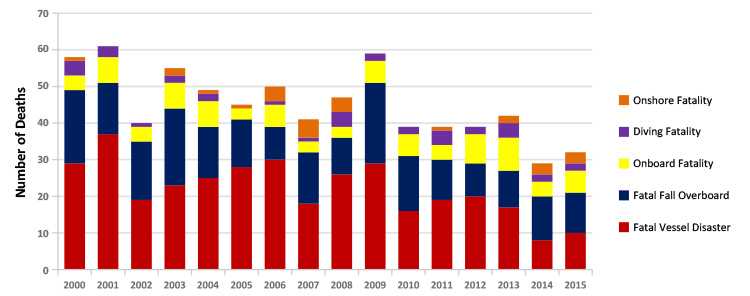COMMERCIAL FISHING SAFETY
Featured Item
Commercial Fishing Regional Fatality Summaries – Five year update

NIOSH recently completed an analysis of commercial fishing fatalities in the United States for the years 2010-2014 in order to identify current hazards among fisheries in different regions of the country: Alaska, West Coast, East Coast, and the Gulf of Mexico.
Commercial Fishing National Overview

Commercial fishing is one of the most dangerous occupations in the United States. Many commercial fishing operations are characterized by hazardous working conditions, strenuous labor, long work hours and harsh weather. During 2000-2015, an annual average of 42 deaths occurred (117 deaths per 100,000 workers), compared with an average of 5,247 deaths (4 per 100,000 workers) among all U.S. workers.1 In 2015, over 9.7 billion pounds of seafood was harvested in the United States earning over $5.2 billion. Species that contributed the most to this revenue include shrimp, Pacific salmon, pollock and lobster. There are approximately 115,000 harvesters in the United States using a variety of different fishing gear and vessels.2
NIOSH maintains the Commercial Fishing Incident Database (CFID), a surveillance system for workplace fatalities in the commercial fishing industry in the United States. A review of the data from 2000-2015 found that:
- 725 commercial fishermen died while fishing in the U.S.
- Nearly half of all fatalities (354, 49%) occurred after a vessel disaster
- Another 221 (30%) fatalities occurred when a fisherman fell overboard
- Another 87 (12%) fatalities resulted from an injury onboard
- The remaining 63 (9%) fatalities occurred while diving or from onshore injuries
US Commercial Fishing Fatalities by Year and Incident Type 2000-2015 (N=725)

Vessel Disasters
There were 354 fatalities that occurred from 212 separate vessel disasters. Of these incidents with known causes†:
- 47 (25%) were initiated by flooding
- 36 (19%) were initiated by being struck by a large wave
- 35 (19%) were initiated by vessel instability
- Severe weather conditions contributed to 116 (55%) of the fatal vessel disasters
Falls Overboard
Among the 221 fatalities that resulted from a person falling overboard and with known causes†:
- 77 (46%) were not witnessed
- Regardless of cause, none* (0%) of the fall overboard victims were wearing a personal flotation device (PFD) when they died
NIOSH Impact On Commercial Fishing Safety
The NIOSH Commercial Fishing Safety Research Program is dedicated to providing our stakeholders high quality, relevant information that has direct impact on the safety of fishermen around the United States. The program’s research has been used by the industry, government agencies, and fishing safety advocates to inform policy decisions and educate workers about the safety hazards and solutions evaluated in the research.
1US Department of Labor, Bureau of Labor Statistics (2016). Injuries, illnesses, and fatalities: Census of Fatal Occupational Injuries (CFOI) –current and revised data. Washington, DC.
2National Marine Fisheries Service (2016). Fisheries of the United States, 2015.
†Missing values were excluded from percentage calculations.
*One fisherman donned an immersion suit before intentionally jumping in the water.
- Page last reviewed: April 5, 2017
- Page last updated: April 5, 2017
- Content source:
- National Institute for Occupational Safety and Health Office of the Director


 ShareCompartir
ShareCompartir